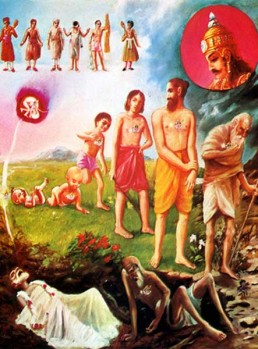Swami Chinmayananda Commentary
In the last two stanzas the discussion naturally turned towards the Ultimate Goal which a Karma Yogin reaches when he has, with evenness-of-mind, perfected the “technique of work.”
The idea seems to be quite appealing and the theory, indeed, logical. There is a ring of conviction in it, when the theory comes from the mouth of Lord Krishna. Arjuna has such a mental constitution that Karma Yoga appeals to him the most.
The grief-sticken hero of the first chapter has forgotten his hysteria and has now come to take an active interest in the discussion. As a practical man, he is afraid as to whether, after gaining this great Goal of Life through Buddhi yoga, he will be able to live so vigorously in the world outside.
Looking from the Vedic usage of the term, one is apt to misunderstand that the perfected Yogin, who has come to rediscover the Self, lives exclusively in a world of his own. The description of the Upanishads can give a novitiate the notion that a Perfected Sage is ill-fitted to live in the world. Arjuna, as a child of the age of hatred and diplomacy, was curious to know fully the condition of the Perfected Master before he actually accepted the theory and tried to live it.
His anxiety to know the entire Truth is clearly shown here in his very questions upon such non-essentials as, ‘How does he speak,’ ‘how will he sit,’ ‘how will he walk,’ etc. These questions must be considered quite appropriate and dramatic, when they come from one who had been, till then, a patient of hysteria. Again, the first-half of the stanza demands a description of a Man-of-Steady-Wisdom while in Samadhi, that is, with regard to his inner life, and the second half is asking for a description of how such a Master will act in the world outside.
Arjuna is asking a forked question: (a) a description of the state of mind in a man-of-realisation merged in Self-experience and, (b) an explanation as to how that experience will influence his actions in the outer world, when he emerges from that Transcendental experience.
In this stanza and the following section, “Man-of-Steady-Wisdom” (Sthita-Prajna), means one who has, through direct realisation, come to experience and live his Godly Self.
THE LORD NOW POINTS OUT THOSE CHARACTERISTIC ATTITUDES IN A REALISED SAINT, WHICH, SINCE ATTAINABLE BY ALL THROUGH RIGHT EFFORT, CONSTITUTE THE MEANS AS SUCH:
Adi Sankara Commentary
O Kesava, ka, what; is the bhasa, description, the language (for the description) — how is he described by others –; sthita-prajnasya, of a man of steady wisdom, of one whose realization, ‘I am the supreme Brahman’, remains steady; samadhi-sthasya, of one who is Self-absorbed? Or kim, how; does the sthitadhih, dhih, man of steady wisdom; himself probhaseta, speak? How does he asita, sit? How does he vrajeta, move about? That is to say, of what kind is his sitting or moving? Through this verse Arjuna asks for a description of the man of steady wisdom.
The Bhagavad Gita with the commentary of Sri Sankaracharya – Translated by Alladi Mahadeva Sastry
Holy Geeta – Commentary by Swami Chinmayananda
The Bhagavad Gita by Eknath Easwaran – Best selling translation of the Bhagavad Gita
The Bhagavad Gita – Translation and Commentary by Swami Sivananda
Bhagavad Gita – Translation and Commentary by Bhaktivedanta Swami Prabupadha
Srimad Bhagavad Gita Chapter 2 – Verse 54 – 2.54 sthita-prajnasya – All Bhagavad Gita (Geeta) Verses in Sanskrit, English, Transliteration, Word Meaning, Translation, Audio, Shankara Bhashya, Adi Sankaracharya Commentary and Links to Videos by Swami Chinmayananda and others – 2-54

